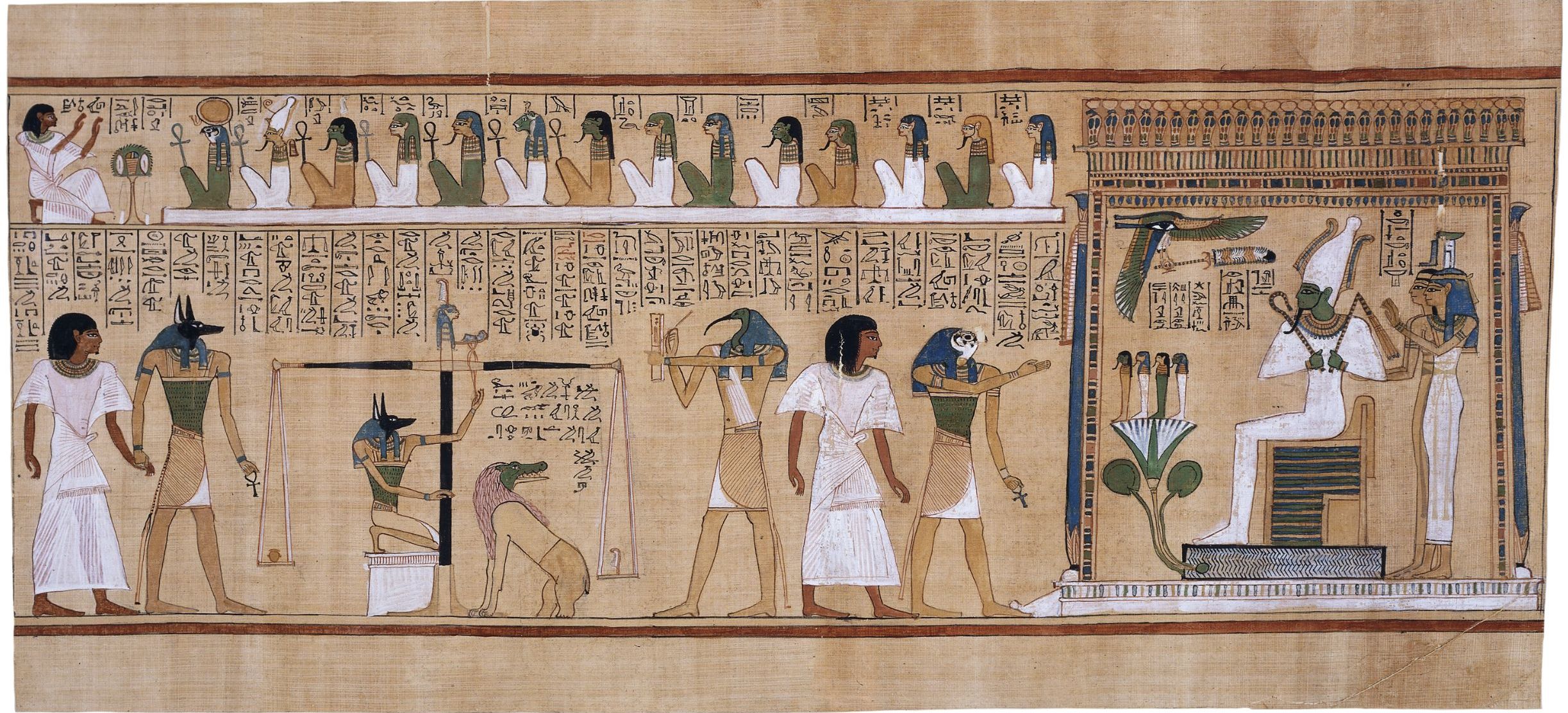Chapter 3: Egyptian Art
Key Notes
- Time Period
- Old Kingdom : 2575–2134 B.C.E.
- New Kingdom : 1550–1070 B.C.E.
- Culture, beliefs, and physical settings
- Egyptian art expresses the ideas of permanence, rebirth, and eternity.
- Egyptian figure styles follow a formula that expresses differences in status.
- Art-making
- Egyptians developed the use of the clerestory to provide light into darkened interiors.
- The god-king is expressed in monumental stone structures the Egypt has became famous for.
- Cultural Interactions
- Egyptian art is sometimes centered on elaborate funerary practices and the numerous artifacts associated with them.
- Audience, functions and patron
- Ancient Near Eastern art concentrates on royal figures and gods.
- Ancient Near Eastern architecture is characterized by ziggurats and palaces that express the power of the gods and rulers.
- Theories and Interpretations
- The study of art history is shaped by changing analyses based on scholarship, theories, context, and written records.
Historical Background
- Egypt gives off the appearance of being a monolithic civilization.
- Historical Egypt begins with the unification of the country under King Narmer in predynastic times, an event or a series of events celebrated on the Narmer Palette.
- Old Kingdom featured massively built monuments to the dead known as pyramids.
- After a period of anarchy, Mentuhotep II unified Egypt for a second time in a period called the Middle Kingdom.
- Pyramid building was abandoned in favor of smaller and less expensive rock-cut tombs.
- One New Kingdom pharaoh, Akhenaton, markedly altered Egyptian society by abandoning the worship of the many gods and substituting one god, Aton, with himself portrayed as his representative on Earth.
- Pharaoh: a king of ancient Egypt
- Aton: Represented as a sun disk emanating rays.
- This religion lead to the change in artistic style called the Amarna period.
- Modern Egyptology began with the 1799 discovery of the Rosetta Stone, from which hieroglyphics could, for the first time, be translated into modern languages.
- The feverish scramble to uncover Egyptian artifacts culminated in 1922 with the discovery of King Tutankhamun’s tomb by Howard Carter.
Patronage and Artistic Life
- Egyptian architecture was designed and executed by highly skilled craftsmen and artisans, not by slaves, as tradition often alleges.
- The process of mummification was handled by embalming experts who were paid handsomely for their exacting and laborious work.
- Most artists like Imhotep, history’s first recorded artist, should more properly be called artistic overseers, who supervised all work under their direction.
- They were likely ordained high priests of Ptah, the god who created the world in Egyptian mythology.
- As the royal builder for King Djoser, Imhotep erected the first and largest pyramid ever built, the Stepped Pyramid.
Egyptian Architecture
- Pyramids were never built alone but as part of great complexes, called necropolises, dedicated to the worship of the spirits of the dead and the preservation of an individual’s ka, or soul.
- Necropolis: literally, a “city of the dead,” a large burial area
- At first, Egyptians buried their dead in more unassuming places called mastabas.
- Mastabas: A simple tomb that has four sloping sides and an entrance for mourners to bring offerings to the deceased.
- The body was buried beneath the mastaba in an inaccessible area that only the spirit could enter.
- Imhotep’s complex included temples with engaged columns.
- Engaged column: a column that is not freestanding but attached to a wall
- Huge monuments such as the Great Sphinx (c. 2500 B.C.E.) were hewn from a single great rock.
- Tombs like those at Beni Hasan were carved into hillsides, hollowing out chambers filled with reserve columns.
- Reserve column: a column that is cut away from rock but has no support function
- In the New Kingdom, temples continued to be built into the sides of rock formations, as at Hatshepsut’s Mortuary Temple (1473–1458 B.C.E.).
- This period also produced freestanding monuments as at Luxor, which had massive pylons on the outside protecting the sanctuary.
- Behind the pylons lay a central courtyard that greeted the worshiper.
- The god was housed in a sacred area just beyond, which was surrounded by a forest of columns, called a hypostyle hall.
- Some of the columns were higher than others, allowing limited light and air to enter the complex, an area called a clerestory.
- Egyptian pyramids are known for their sleek solid surfaces and their monumental scale.
- They are made from stone blocks and built without mortar.
- Once the dead were interred, no one was permitted entry into these sealed structures.
- Columns used in New Kingdom temples were based on plant shapes: the lotus, the palm, and the papyrus.
- Papyrus: a tall aquatic plant whose fiber is used as a writing surface in ancient Egypt
- These column types reflected early construction methods done at a time when Egyptian buildings were supported by perishable materials.
Egyptian Painting and Sculpture
- Sarcophagi: These are stone coffins.
- Hieroglyphics: It describes the deceased and his or her accomplishments in great detail, without which the dead would have incomplete afterlives.
- Writing appears both on relief sculpture and on sculpture in the round, as well as on a paper surface called papyrus.
- Relief sculpture: sculpture which projects from a flat background. A very shallow relief sculpture is called a bas-relief
- Episodes of violence and disorder are limited only to scenes of slaughtering animals for sacrifices or overthrowing the forces of evil; otherwise, Egyptian art is a picture of contentment and stability.
- Figures rest on a ground line often at the front of the picture plane.
- Ground line: a baseline upon which figures stand
- When figures are placed on a line above in a register, they are thought to be receding into the distance.
- Register: a horizontal band, often on top of another, that tells a narrative story
➼ Palette of King Narmer
Details
- From Predynastic Egypt
- 3000–2920 B.C.E.
- A graywacke
- Found in Egyptian Museum, Cairo
Form
- Hierarchy of Scale
- Figures stand on a ground line.
- Narrative.
- Schematic lines delineate Narmer’s muscle structure: forearm veins and thigh muscles are represented by straight lines, the kneecaps by half circles.
- Composite view of the human body: mostly seen in profile, but chest, eye, and ear are frontal.
- Hieroglyphics explain and add to the meaning, and they identify Narmer in the cartouche.
Function
- Palette used to prepare eye makeup for the blinding sun, although this palette was probably commemorative.
- Palettes carved on two sides were for ceremonial purposes.
Content
- Relief sculpture depicting King Narmer uniting Upper and Lower Egypt.
- Depicted four times at the top register is Hathor, a god as a cow with a woman’s face, or Bat, a sky goddess who has the power to see the past and the future, or a bull which symbolizes the power and strength of the king.
- On the front:
- Narmer, the largest figure, wears the Lower Egyptian cobra crown and inspects the enemy's beheaded corpses from above.
- Narmer's sandal bearer follows four standard bearers and a priest.
- In the center, mythical animals with long necks are harnessed, possibly symbolizing unification. At the bottom, a bull destroys a city fortress. — Narmer knocking over his enemies.
- On the back:
- The falcon is Horus, god of Egypt, who triumphs over Narmer’s foes; Horus holds a rope around a man’s head and a papyrus plant, symbols of Lower Egypt.
- Narmer has a symbol of strength, the bull’s tail, at his waist; wears a bowling-pin-shaped crown as king of united Egypt, beating down an enemy.
- A servant behind Narmer holds his sandals as he stands barefoot on the sacred ground as a divine king.
- Defeated Egyptians lie beneath his feet.
Theories
- Represents the unification of Upper and Lower Egypt under one ruler.
- Unification is expressed as a concept or goal to be achieved.
- May represent a balance of order and chaos.
- May reference the journey of the sun god.
Image
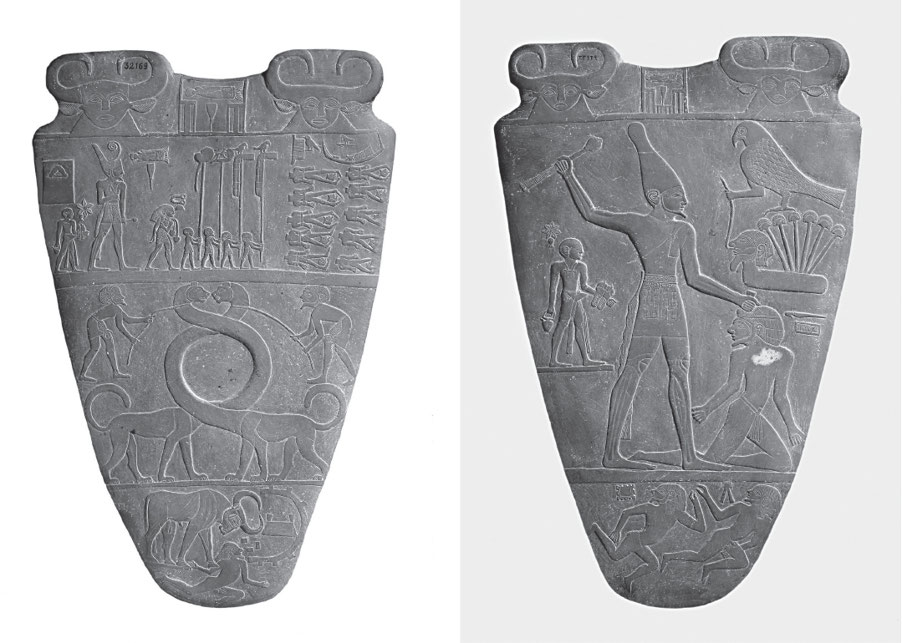
➼ Seated Scribe
Details
- From Saqqara, Egypt, Old Kingdom, 4th Dynasty
- c. 2620–2500 B.C.E.
- A painted limestone
- Found in Louvre, Paris
Form
- Not a pharaoh: sagging chest and realistic body rather than the idealistic features reserved for a pharaoh; the scribe contrasts with the ideally portrayed pharaoh.
- Figure has high cheekbones, hollow cheeks, and a distinctive jawline.
- Meant to be seen from the front.
- Color still remains on the sculpture.
Function: Created for a tomb at Saqqara as a provision for the ka.
Content
- Amazingly lifelike but not a portrait—rather, it’s a conventional image of a scribe.
- Inlaid crystal eyes.
- Holds papyrus in his lap; his writing instrument (now gone) was in his hand ready to write.
Context
- Attentive expression; thin angular face; in readiness for the words the pharaoh might dictate.
- Seated on the ground to indicate his comparative low station.
Image
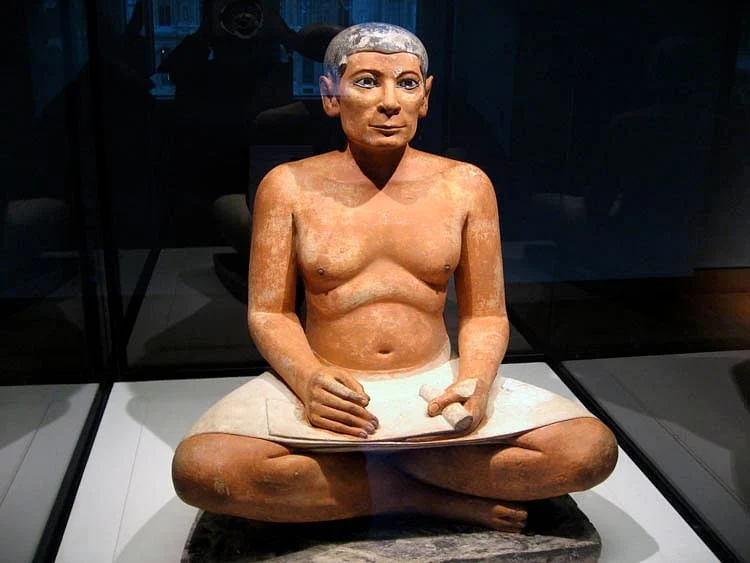
➼ Great Pyramids (Menkaura, Khafre, and Khufu)
Details
- c. 2550–2490 B.C.E.
- From Old Kingdom, 4th Dynasty
- A cut limestone,
- Found in Giza, Egypt
Form
- Each pyramid is a huge pile of limestone with a minimal interior that housed the deceased pharaoh.
- Each pyramid had an enjoining mortuary temple used for worship.
Function
- Giant monuments to dead pharaohs: Menkaura, Khufu, and Khafre.
- Preservation of the body and tomb contents for eternity.
- Some scholars also suggest that the complex served as the king’s palace in the afterlife.
Context
- Each pyramid has a funerary complex adjacent connected by a formal pathway used for carrying the dead pharaoh’s body to the pyramid to be interred.
- Shape may have been influenced by a sacred stone relic called a benben, which is shaped like a sacred stone found at Heliopolis.
- Heliopolis was the center of the sun god cult.
- Each side of the pyramid is oriented toward a point on the compass, a fact pointing to an association with the stars and the sun.
- Giza temples face east, the rising sun, and have been associated with the god Re.
Image
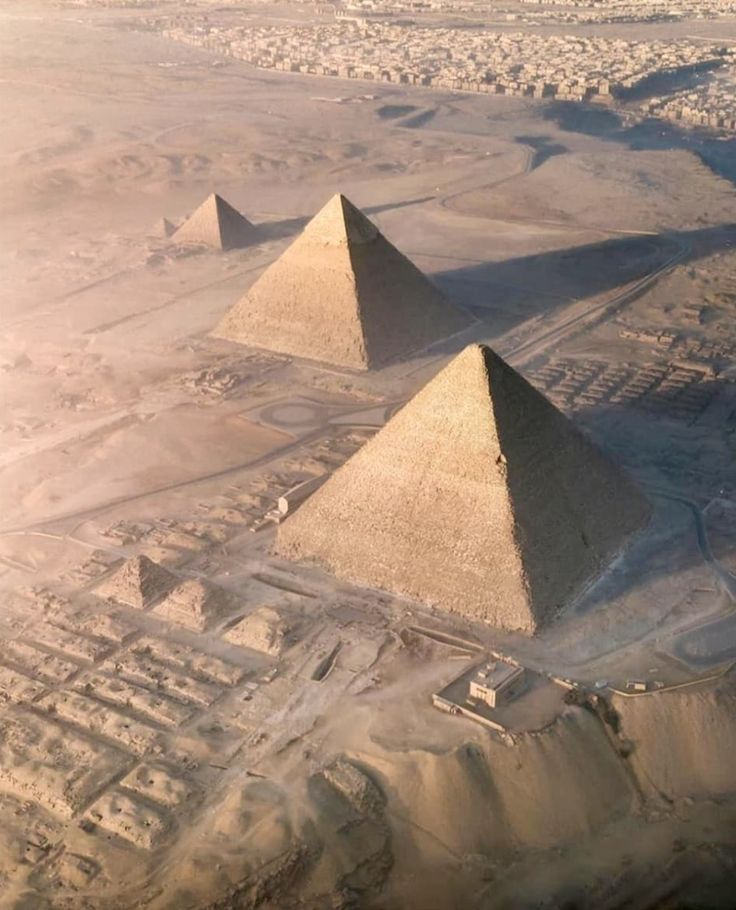
➼ Great Sphinx
Details
- C. 2500 B.C.E.
- A limestone
- Found in Giza, Egypt
Form
- Carved in situ from a huge rock; colossal scale.
- In situ: a Latin expression that means that something is in its original location
- Body of a lion, head of a pharaoh and/or god.
- Originally brightly painted to stand out in the desert behind the figure, which once rose near ramps rising from the Nile.
Function: The Sphinx seems to be protecting the pyramids behind it, although this theory has been debated.
Context and Interpretation
- Very generalized features, although some say it may be a portrait of Khafre.
- Cats are royal animals in ancient Egypt, probably because they saved the grain supply from mice.
History
- Head of the Sphinx badly mauled in the Middle Ages.
- Fragment of the Sphinx’s beard is in the British Museum.
Image
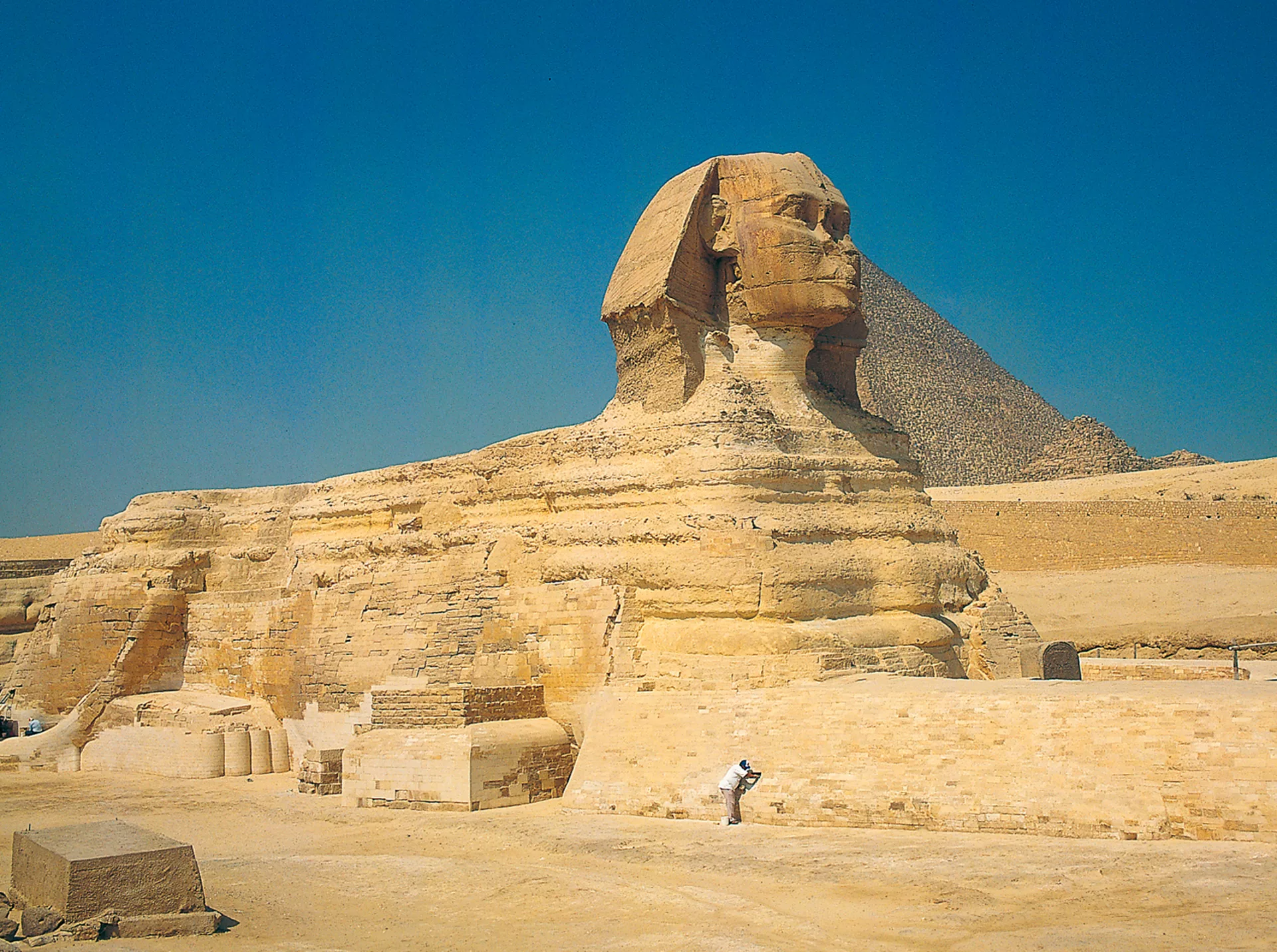
➼ King Menkaura and Queen
Details
- From the Old Kingdom, 4th Dynasty
- 2490– 2472 B.C.E.
- A graywacke
- Found in Museum of Fine Arts, Boston
Form
- Two figures attached to a block of stone; arms and legs not cut free.
- Traces of red paint exist on Menkaura’s face and black paint on the queen’s wig.
- Figures seem to stride forward, but simultaneously are anchored to the stone behind; it is unusual for the female figure to be striding with the male.
- Figures stare out into space (the afterlife?).
Function
- Receptacle for the ka of the pharaoh and his queen.
- Ka: the soul, or spiritual essence, of a human being that either ascends to heaven or can live in an Egyptian statue of itself
- Wife’s simple and affectionate gesture, and/or presenting him to the gods.
Materials: Extremely hard stone used; symbolizes the permanence of the pharaoh’s presence and his strength on earth.
Context
- Menkaura’s powerful physique and stride symbolize his kingship, as does his garb: nemes on the head, an artificial beard, and a kilt with a tab.
- Original location was the temple of Menkaura’s pyramid complex at Giza.
- Society’s view of women is expressed in the ankle-length tightly draped gown covering the queen’s body; men and women of the same height indicated equality.
- Society’s view of the king is expressed in his broad shoulders, muscular arms and legs, and firm stomach.
Image
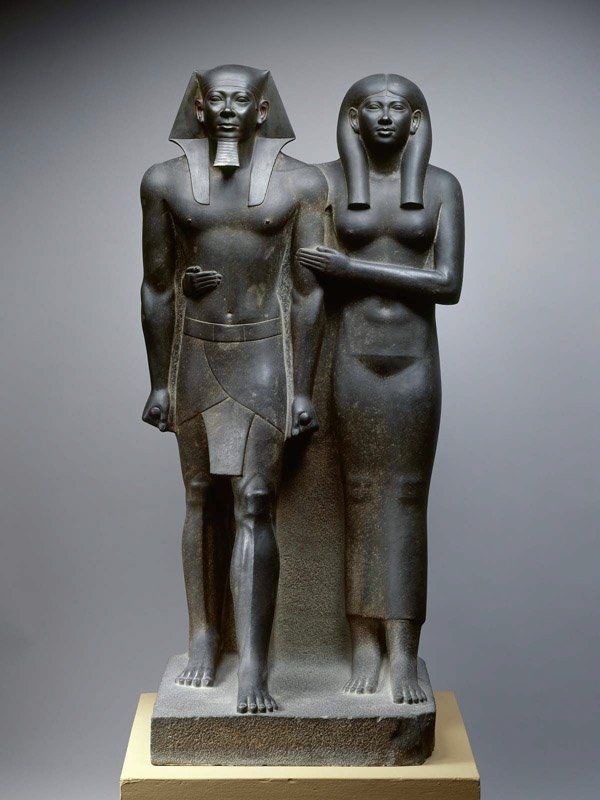
➼ Temple of Amun-Re and Hypostyle Hall
Details
- Temple: 1550 B.C.E.
- Hall: 1250 B.C.E.
- From New Kingdom, 18th and 19th Dynasties
- A cut sandstone and mud brick
- Found in Karnak, near Luxor, Egypt
- Hypostyle: a hall that has a roof supported by a dense thicket of columns
Form
- Axial plan: a building with an elongated ground plan
- Pylon temple.
- Pylon: a monumental gateway to an Egyptian temple marked by two flat, sloping walls between which is a smaller entrance
- Hypostyle halls.
- Massive lintels link the columns together.
- Huge columns, tightly packed together, admit little light into the sanctuary.
- Tallest columns have papyrus capitals; a clerestory allows some light and air into the darkest parts of the temple.
- Clerestory: a roof that rises above lower roofs and thus has window space beneath carved into a surface so that the figures seem to project forward
- Columns elaborately painted.
- Columns carved in sunken relief.
- Sunken relief: a carving in which the outlines of figures are deeply
- Bottom of columns have bud capitals.
- Massive walls enclose complex.
- Enter complex through massive sloped pylon gateway into a peristyle courtyard, then through a hypostyle hall, and then into the sanctuary, where few were allowed.
- Peristyle: a colonnade surrounding a building or enclosing a courtyard
Function
- Egyptian temple for the worship of Amun-Re.
- God housed in the darkest and most secret part of the complex, only accessed by priests and pharaohs.
Context
- Adjacent is an artificial sacred lake—a symbol of the sacred waters of the world that existed before time.
- Located on the east side of the Nile, linked by a road with the Karnak temple for the Opet festival.
- The complex was built near this lake over time; symbolically, it arose from the waters the way civilization did.
- Theory that the temple represents the beginnings of the world:
- Pylons are the horizon.
- Floor rises to the sanctuary of the god.
- Temple roof is the sky.
- Columns represent plants of the Nile: lotus, papyrus, palm, etc.
History
- Built by succeeding generations of pharaohs over a great expanse of time.
Image

➼ Mortuary Temple of Hatshepsut
Details
- c. 1473–1458 B.C.E.
- New Kingdom, 18th Dynasty,
- A sandstone partly carved into a rock cliff
- Found near Luxor, Egypt
Form
- Three colonnaded terraces and two ramps.
- Visually coordinated with the natural setting; long horizontals and verticals of the terraces and colonnades repeat the patterns of the cliffs behind; patterns of dark and light in the colonnade are reflected in the cliffs.
Function
- Hatshepsut declared that she built the temple as “a garden for my father, Amun”
- Only used for special religious events; lacks subsidiary buildings for offering storage, priest housing, temple administration, workshops, and other functions.
- Cultic purity prevented the royal burial in the temple.
- Valley of the Kings led to the royal tomb in the mountain behind the temple.
Context
- First time the achievements of a woman are celebrated in art history; Hatshepsut’s body is interred elsewhere.
- Temple aligned with the winter solstice, when light enters the farthest section of the interior.
- Located on the west side of the Nile across from Thebes.
- Perhaps designed by Senenmut, a high-ranking official in Hatshepsut’s court.
Image
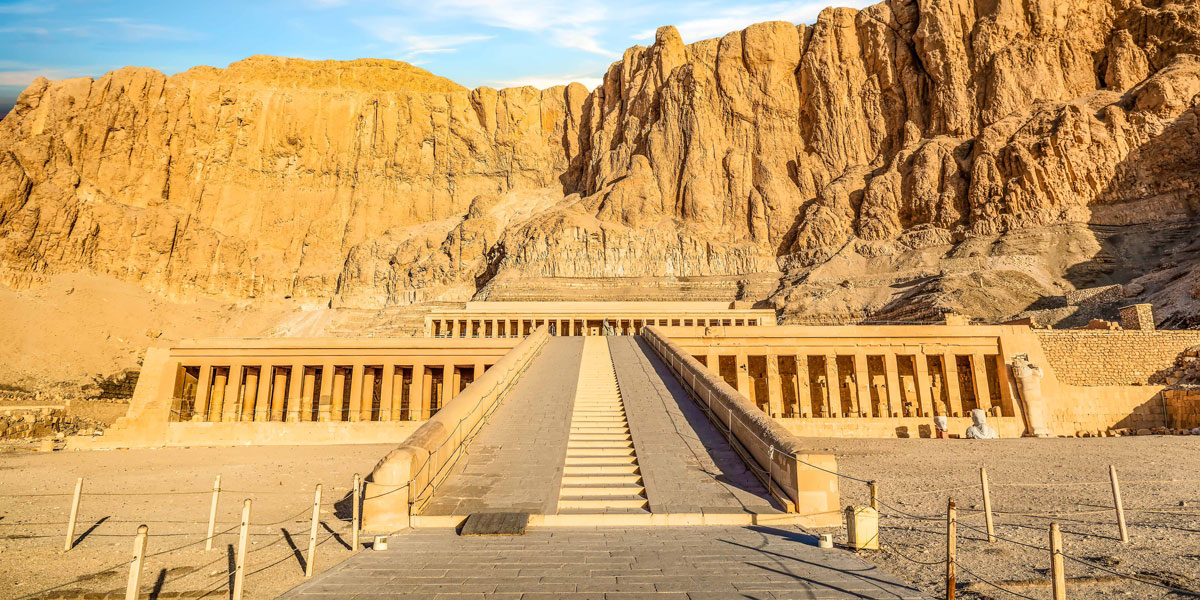
➼ Kneeling Statue of Hatshepsut
Details
- 1473–1458 B.C.E.
- Made of red granite
- Found in the Metropolitan Museum of Art, New York
Form
- Male pharaonic attributes: nemes or headcloth, false beard, kilt.
- Wears the white crown of Upper Egypt.
- Queen is depicted in male costume of a pharaoh, yet slender proportions and slight breasts indicate femininity.
Function
- Statue of the god brought before sculpture in a procession.
- Processions up the mortuary temple passed in front of this statue of Hatshepsut.
- One of 200 statues placed around the complex.
Context
- One of 10 statues of Hatshepsut with offering jars, part of a ritual in honor of the sun god; pharaoh would kneel only before a god.
- Inscription on base says she is offering plants to Amun, the sun god.
Image
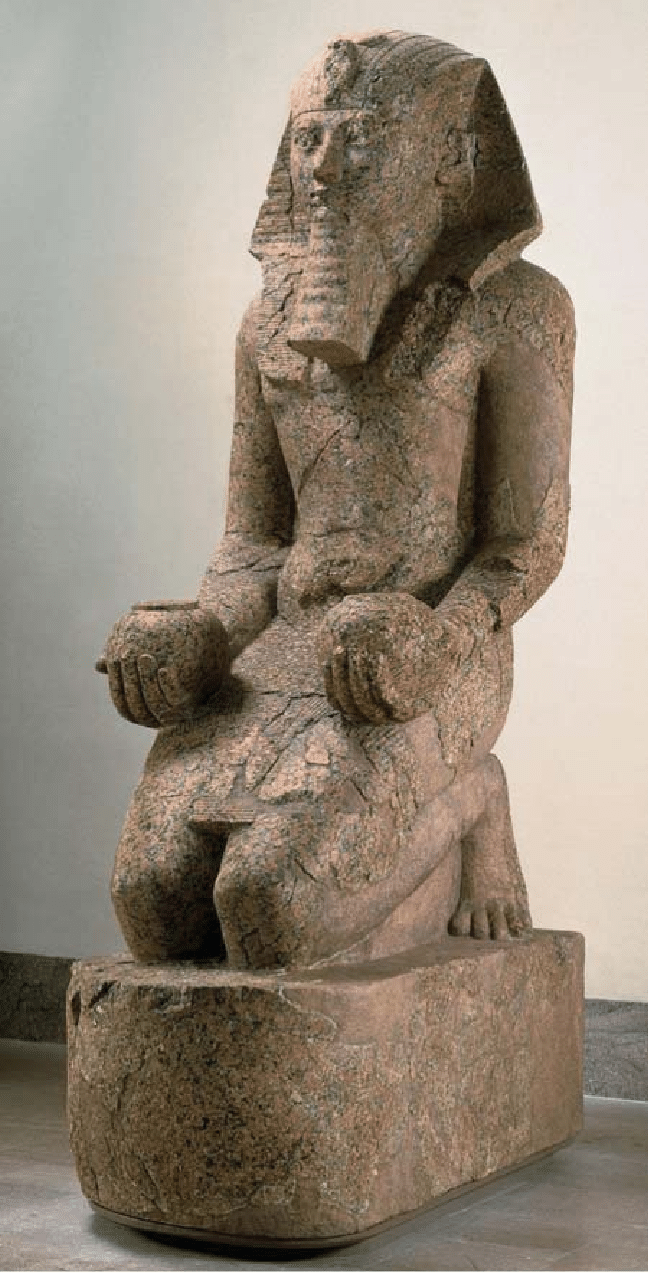
➼ Akhenaton, Nefertiti, and Three Daughters
Details
- 1353–1335 B.C.E.
- New Kingdom (Amarna) 18th Dynasty
- Made up of limestone
- Found in Egyptian Museum, Berlin
Content
- Akhenaton holds his eldest daughter (left), ready to be kissed.
- Nefertiti holds her daughter (right) with another daughter on her shoulder.
- Intimate family relationships are extremely rare in Egyptian art.
Form
- State religion shift indicated by an evolving style in Egyptian art:
- Smoother, curved surfaces
- Low-hanging bellies.
- Slack jaws.
- Thin arms.
- Epicene bodies.
- Heavy-lidded eyes.
- At the end of the sun’s rays, ankhs point to the king and queen.
- Ankh: an Egyptian symbol of life
Function: The domestic environment was new in Egyptian art; the panel is for an altar in a home
Technique
- Sunken relief, which is less likely to be damaged than raised relief.
- Sunken relief creates deeper shadows and can be appreciated in the sunlight.
Context
- Akhenaton abandoned Thebes and created a new capital, originally named Akhenaton and later changed to Amarna; the style of art from this period is called the Amarna Style.
- Amarna style: art created during the reign of Akhenaton, which features a more relaxed figure style than in Old and Middle Kingdom art
- The state religion was changed by Akhenaton to the worship of Aton, symbolized by the sun-disk with a cobra; he changed his name from Amenhotep IV to Akhenaton to reflect his devotion to the one god Aton.
- Akhenaton and Nefertiti are having a private relationship with their new god, Aton.
- After Akhenaton’s reign, the Amarna style was slowly replaced by more traditional Egyptian representations.
Image
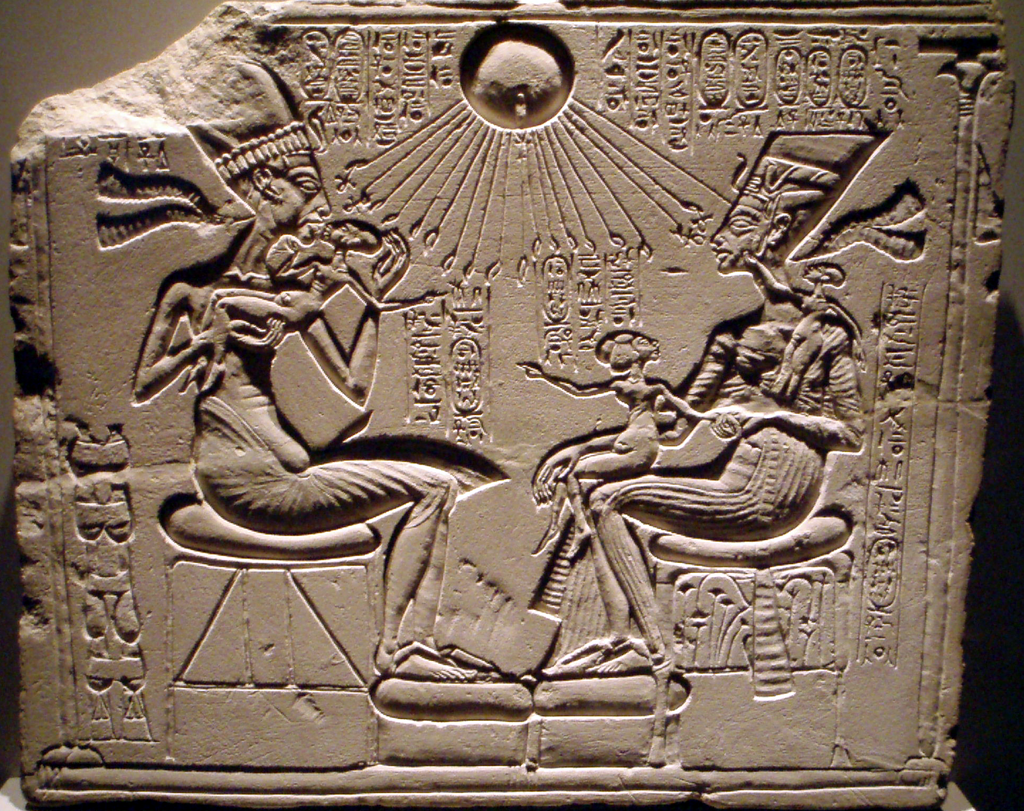
➼ Innermost Coffin of King Tutankhamun’s tomb
Details
- From New Kingdom, 18th Dynasty
- c. 1323 B.C.E.
- A gold with an inlay of enamel and semi-precious stones
- Found in Egyptian Museum, Cairo
Form
- Gold coffin (6 feet, 7 inches long) containing the body of the pharaoh.
- Smooth, idealized features on the mask of the boy king.
- Holds a crook and a flail, symbols of Osiris.
Function: Mummified body of King Tutankhamun was buried with 143 objects, on his head, neck, abdomen, and limbs; a gold mask was placed over his head.
Context
- When Akhenaton died, two pharaohs ruled briefly, and then his son Tutankhamun reigned for ten years, from age 9 to 19.
- Tutankhamun’s father and mother were brother and sister; his wife was his half-sister; perhaps he was physically handicapped because of genetic inbreeding.
History: Famous tomb was discovered by Howard Carter in 1922.
Image
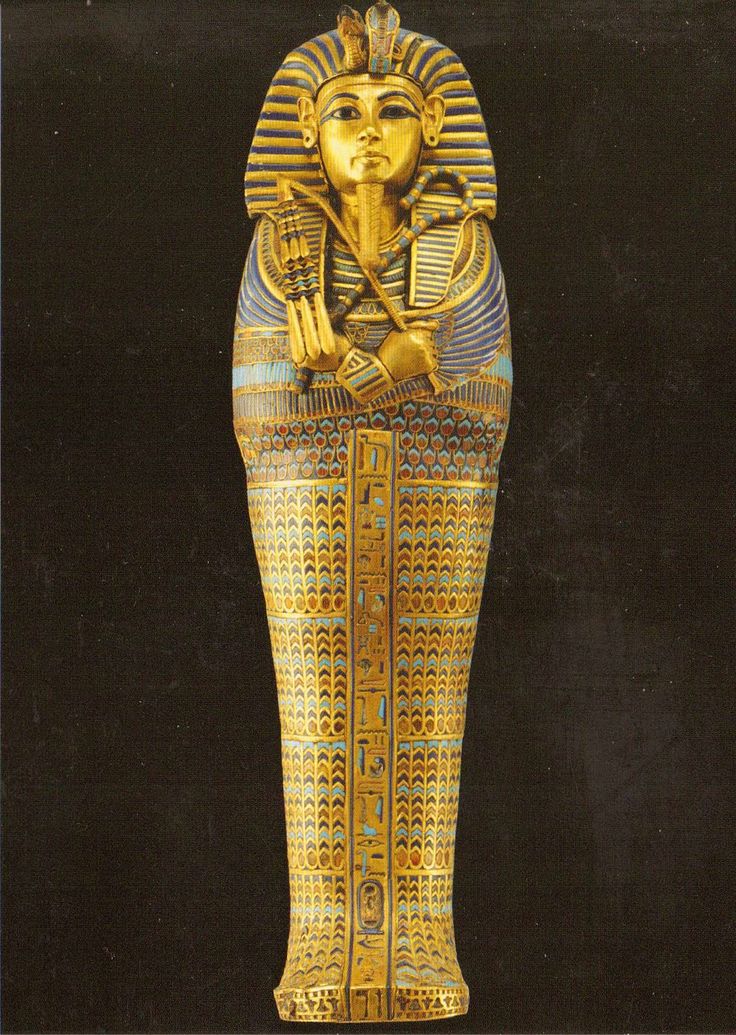
➼ Last Judgment of Hunefer
Details
- Page from the Book of the Dead
- From New Kingdom, 19th Dynasty
- c. 1275 B.C.E.
- A painted papyrus scroll
- Found in British Museum, London
Form: Narrative on a uniform register (read right to left).
Function: Illustration from the Book of the Dead, an Egyptian book of spells and charms that acted as a guide for the deceased to make his or her way to eternal life.
Content
- Top register — Hunefer in white at left before a row of judges.
- Main register — the jackal-headed god of embalming, Anubis, leads the deceased into a hall, where his soul is weighed against a feather. If his sins weigh more than a feather, he will be condemned.
- Ammit: The hippopotamus/lion figure; between the scales, will eat the heart of an evil soul.
- Thoth: A god who has the head of a bird; the stenographer writing down these events in the hieroglyphics that he invented.
- Osiris: god of the underworld, enthroned on the right; will subject the deceased to a day of judgment.
Context
- Hunefer: A scribe who had priestly functions.
Image
